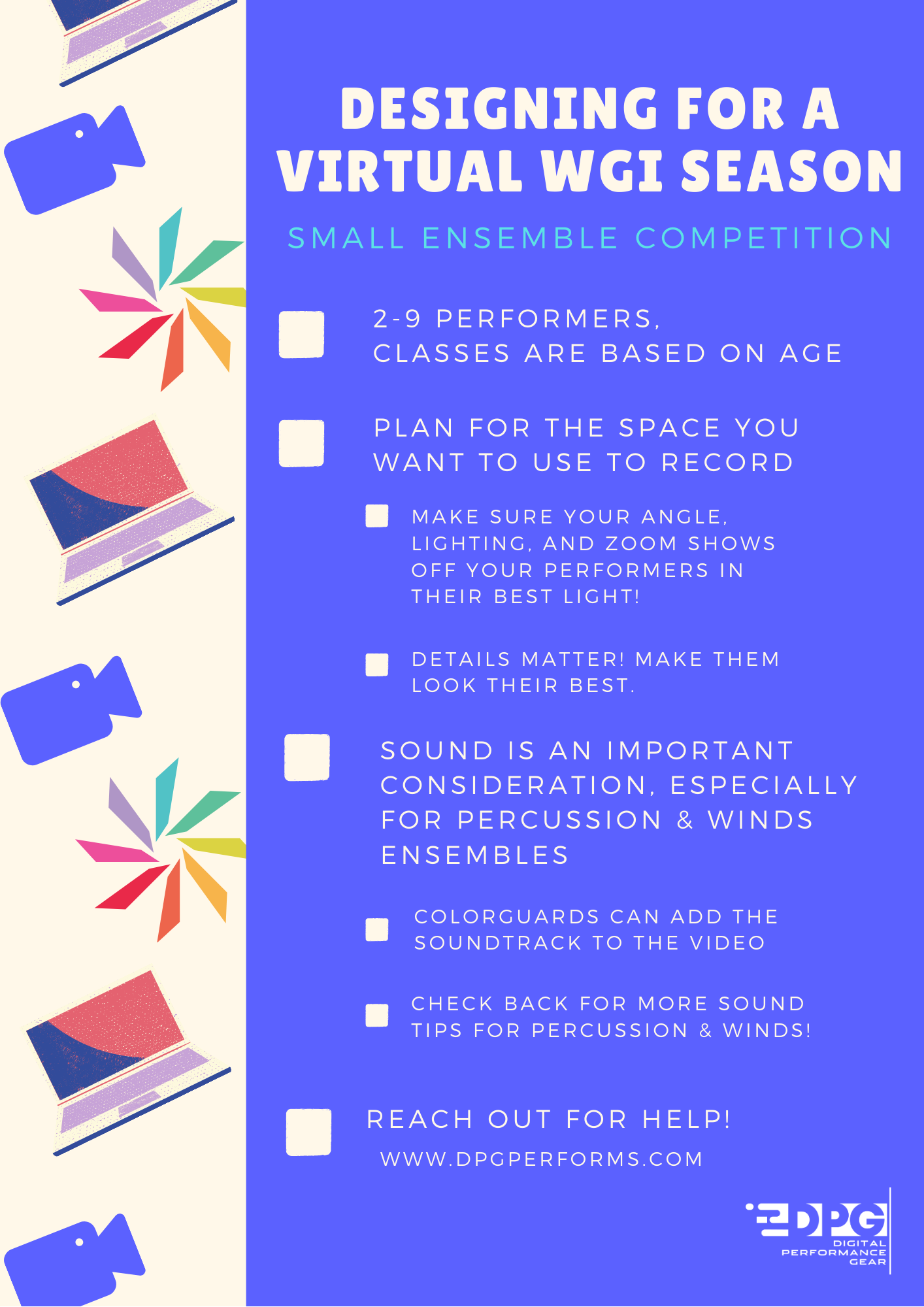Designing for a Virtual Season in 2021
Part 2: Small Ensembles
On Monday, September 28, 2020, WGI announced that their 2021 season would be conducted virtually in light of the restrictions on national events and travel for many teams as we continue to deal with the COVID-19 pandemic. While we, like you, are sad to lose another season of in-person marching arts, the virtual season gives performers a chance to shine on a national level through WGI’s competitive and non-competitive group divisions, small ensemble division, and solo division. In this installment, we’ll take a look at the small ensemble division for colorguards, percussion, and winds. Be sure to check out our article on the group competitive division as well- remember, you can do both!

Learn more at www.wgi.org
Virtual Small Ensemble Competition
The small ensemble option gives your students the opportunity to compete without the bringing together large groups of people and is especially great for areas of the country that may have greater restrictions, less available practice space, or less budget available this season.
Virtual Small Ensemble Classes
Rather than being based on a particular skill level, small ensemble classes are based on age and are divided into 13 and younger, ages 14-18, and ages 19+. These classes are the same for colorguard, percussion, and winds. All small ensembles can be comprised of 2-9 members. Your students can participate in multiple ensembles, and your school or team can have any number of small ensembles compete.
Virtual Small Ensemble Rules
Virtual Colorguard Ensembles
Ensembles in the colorguard division are divided into Flag Ensembles, Weapon Ensembles, Movement Ensembles, or Mixed Ensembles (these include multiple pieces of equipment). Timing in colorguard is restricted to 1.5 to 4.5 minutes. You can select any genre of music for your ensemble performance. Check out the complete rules here.
Virtual Percussion and Winds Ensembles
Ensembles in the percussion and winds divisions are divided into Woodwind, Brass, Percussion, or Mixed (any instrumentation). Your percussion and winds small ensemble should be between two minutes and 4.5 minutes in length. You also have the option to use a live piano accompaniment or a recorded track with your performance. Check out the complete rules for winds and percussion here.

INFINITY World from Orlando, FL (2019)
Competition Area
Much like the group competition rules, the small ensemble rules allow you to use any space, indoors or outdoors, and there are no boundaries or restrictions on the amount of space you can use. More traditional performance spaces like gyms are certainly an option, but you can also use a stage, outdoor courtyards, football or practice fields, band rooms, or anywhere else that best fits your needs.
Video Guidelines
Much like the group competitive division, your video must be filmed in one take, from one camera. You cannot edit or splice footage together. However, in the small ensemble division there is no restriction about where the camera needs to be placed, or restrictions on zooming. This means your camera can be at any angle that best shows off the performers, and it can move. If you intend to zoom or move that camera during the performance, get ready to practice, just like your performers are practicing! Make sure that your camera choices are enhancing the performance and not impeding it. Sound is a major consideration for camera placement in the percussion and winds division- look for a separate article about that soon! Colorguard, however, has the option to add sound to the video after the recording.
Designing for small ensembles.
Colorguard
In the colorguard division, the program is a consideration on the scoring sheet. This includes creativity, artistry and entertainment value, communication and showmanship, style, crafting, and production value. You’ll want to look at the big picture, just like you would a typical winterguard show, as you’re putting your ideas together.
Your set can play a big role in your small ensemble production. While you can use a floor, you certainly don’t have to, but you do want to carefully consider where you will film before you decide. If you’re using an outdoor space, do you want your performers to interact with objects that might be fixed in that space? Like benches, stairs, etc. If so, you’re going to have to plan for that in your choreography. If you’re using a more traditional space like a gym or band room and intend to record from above, a small floor will give you a lot of visual impact and can help pull your thematic ideas together. If you’re recording on a stage in an auditorium, backdrops are probably going to be more impactful than a floor if you’d like to bring in some color, pattern, or theme to the program.
Wherever you decide to stage your production, be sure to test your lighting and angles before you record. Do a couple of practice runs for the performers, but also for the videographer. If you’re planning to record from a fixed point but want the ability to pan and zoom, you may want to be sure you invest in or borrow a decent tripod. Shaky video is not doing your performers any justice! Colorguards have the option of adding sound to the video after recording. If you have the ability to do so, this will help with ambient noise.
You don’t have to spend a fortune on your small ensemble, but you do need to make good choices to help them be successful. Be detailed about costuming, flags, make-up, hair, taping your equipment properly – all the details you would normally be agonizing over if you were headed to the tunnel instead of recording at your school or practice facility. Encourage your performers to be part of the process and help guide them. This can be a fun teaching and learning experience for all of the future designers in your ensemble!

North Lamar HS (TX) was a finalist in several regionals in 2020, competing with only 8 members. Be sure to check out some of the great small teams from past seasons when thinking about your small ensemble designs.
Percussion
Your percussion small ensemble can have any percussion instrumentation you’d like. It can be a concert ensemble or a marching ensemble, or a combination of the two. We will have a separate article that focuses on controlling the soundscape of your ensemble but think about this when you’re planning your video. Unlike colorguard, you can’t pipe in the sound to the video after you record. What you record is what you send in, both audio and visual. So, just as you test the lighting and angles for your video before you record, test your sound.
Like colorguard, you have the option of being inside or out, and using floors, set pieces, or the actual physical environment to enhance your production. WGI expects to have updated judge’s sheets available in mid-November, so be sure to check back for those.

Percussion small ensembles can keep your students focused on performance goals while expanding their skill sets!
Winds
The winds small ensemble can be all woodwind, all brass, or a mixed ensemble that includes any combination of woodwinds, brass, and percussion. This is a great performance opportunity for your musicians but be sure you focus on the quality of sound, technique, musicianship, and the composition of your arrangement first. You will also need to consider the sound in your recording space carefully. WGI is updating the scoring criteria for this division, so be sure to check back in mid-November.

University of Texas Rio Grande Valley Winds from Edinburg, TX (2019)
Designing for A Virtual Season Guide: Small Ensembles

Download a Copy: DPG Designing for a Virtual Small Ensemble
We’re here to help!
Most of our custom products have a low eight item minimum, so if you’re looking for something unique for your small ensemble, our account executives are here to help. Check out our new website for inspiration, and don’t be afraid to have a conversation with us about your goals and ideas for 2021. We produce everything you need for your show- floors, uniforms, props, flyovers, flags, face masks, bell covers, and more- under one roof at our facility in Conroe, Texas. Get everything you need designed at once, with one bill- your bookkeeper will love you, and your designs will be flawlessly matched. Reach out today!
Don’t forget about our Fall Sale, happening now through November 30, 2020! Save 15% on all custom-printed floors, uniforms, props, flyovers, flags, and so much more!




